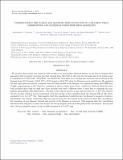Files in this item
Understanding the plasma and magnetic field evolution of a filament using observations and non-linear force-free field modelling : evolution of an intermediate filament
Item metadata
| dc.contributor.author | Yardley, Stephanie Louise | |
| dc.contributor.author | Savcheva, Antonia | |
| dc.contributor.author | Green, Lucie M. | |
| dc.contributor.author | van Driel-Gesztelyi, Lidia | |
| dc.contributor.author | Long, David | |
| dc.contributor.author | Williams, David R. | |
| dc.contributor.author | Mackay, Duncan Hendry | |
| dc.date.accessioned | 2019-11-05T15:30:06Z | |
| dc.date.available | 2019-11-05T15:30:06Z | |
| dc.date.issued | 2019-12-23 | |
| dc.identifier | 262739020 | |
| dc.identifier | 89d20c31-2468-4d59-9944-c377cd04a221 | |
| dc.identifier | 85077304061 | |
| dc.identifier | 000506012000134 | |
| dc.identifier.citation | Yardley , S L , Savcheva , A , Green , L M , van Driel-Gesztelyi , L , Long , D , Williams , D R & Mackay , D H 2019 , ' Understanding the plasma and magnetic field evolution of a filament using observations and non-linear force-free field modelling : evolution of an intermediate filament ' , Astrophysical Journal , vol. 887 , no. 2 , 240 . https://doi.org/10.3847/1538-4357/ab54d2 | en |
| dc.identifier.issn | 0004-637X | |
| dc.identifier.other | ORCID: /0000-0001-6065-8531/work/67525848 | |
| dc.identifier.uri | https://hdl.handle.net/10023/18852 | |
| dc.description | Funding: UK STFC via PhD studentship and the Consolidated Grant SMC1/YST025 (S.L.Y.); STFC and Leverhulme trust (D.H.M.). | en |
| dc.description.abstract | We present observations and magnetic field models of an intermediate filament present on the Sun in August 2012, associated with a polarity inversion line that extends from AR 11541 in the east into the quiet sun at its western end. A combination of SDO/AIA, SDO/HMI, and GONG Hα data allow us to analyse the structure and evolution of the filament from 2012 August 4 23:00 UT to 2012 August 6 08:00 UT when the filament was in equilibrium. By applying the flux rope insertion method, nonlinear force-free field models of the filament are constructed using SDO/HMI line-of-sight magnetograms as the boundary condition at the two times given above. Guided by observed filament barbs, both modelled flux ropes are split into three sections each with a different value of axial flux to represent the non-uniform photospheric field distribution. The flux in the eastern section of the rope increases by 4x1020 Mx between the two models, which is in good agreement with the amount of flux cancelled along the internal PIL of AR 11541, calculated to be 3.2x1020 Mx. This suggests that flux cancellation builds flux into the filament's magnetic structure. Additionally, the number of field line dips increases between the two models in the locations where flux cancellation, the formation of new filament threads and growth of the filament is observed. This suggests that flux cancellation associated with magnetic reconnection forms concave-up magnetic field that lifts plasma into the filament. During this time, the free magnetic energy in the models increases by 0.2 x 1031 ergs. | |
| dc.format.extent | 14 | |
| dc.format.extent | 5552928 | |
| dc.language.iso | eng | |
| dc.relation.ispartof | Astrophysical Journal | en |
| dc.subject | Sun: activity | en |
| dc.subject | Sun: filaments, prominences | en |
| dc.subject | Sun: coronal mass ejections (CMEs) | en |
| dc.subject | Sun: evolution | en |
| dc.subject | Sun: magnetic fields | en |
| dc.subject | Sun; photosphere | en |
| dc.subject | QB Astronomy | en |
| dc.subject | QC Physics | en |
| dc.subject | 3rd-DAS | en |
| dc.subject.lcc | QB | en |
| dc.subject.lcc | QC | en |
| dc.title | Understanding the plasma and magnetic field evolution of a filament using observations and non-linear force-free field modelling : evolution of an intermediate filament | en |
| dc.type | Journal article | en |
| dc.contributor.sponsor | Science & Technology Facilities Council | en |
| dc.contributor.institution | University of St Andrews. Applied Mathematics | en |
| dc.identifier.doi | https://doi.org/10.3847/1538-4357/ab54d2 | |
| dc.description.status | Peer reviewed | en |
| dc.identifier.grantnumber | ST/N000609/1 | en |
This item appears in the following Collection(s)
Items in the St Andrews Research Repository are protected by copyright, with all rights reserved, unless otherwise indicated.

